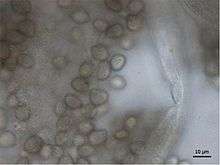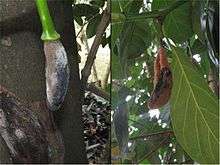Black bread mold
| Black bread mold | |
|---|---|
 | |
| Scientific classification | |
| Kingdom: | Fungi |
| Order: | Mucorales |
| Family: | Mucoraceae |
| Genus: | Rhizopus |
| Species: | R. stolonifer |
| Binomial name | |
| Rhizopus stolonifer (Ehrenb.: Fr.) Vuill. | |
| Synonyms | |
|
Ascophora mucedo | |
Black bread mold (Rhizopus stolonifer) is a widely distributed thread-like mucoralean mold. Commonly found on bread surfaces, it takes food and nutrients from the bread and causes damage to the surface where it lives.
Asexual spores are formed within pinhead-like sporangia, which break to release the spores when mature. Germination of these spores forms the haploid hyphae of a new mycelium. R. stolonifer grows rapidly at temperatures between 15 and 30°C.[1]
R. stolonifer is a heterothallic species,[2] in that sexual reproduction happens only when opposite mating types (designated + and -) come in contact. Successful mating results in the formation of durable zygospores at the point of contact. Subsequently, the zygospore germinates and forms a sporangiophore whose sporangium contains both + and - haploid spores. The two varieties are: R. stolonifer var. stolonifer,which produces straight, erect sporangiophores, and those of R. stolonifer var. lyococcos are curved.[1] A closely related species, Rhizopus sexualis, differs primarily in being homothallic (self-compatible).
Distribution and habitat

Black bread mold has a cosmopolitan distribution. It is capable of causing opportunistic infections of humans (zygomycosis). It also causes Rhizopus soft rot in sweet potatoes.
References
External links
- Time lapse video of Rhizopus stolonifer attacking strawberries at the Cornell Mushroom Blog.
- An Informative, Heart-Warming Tale about Black Bread Mold General information, diagrams, growth video.